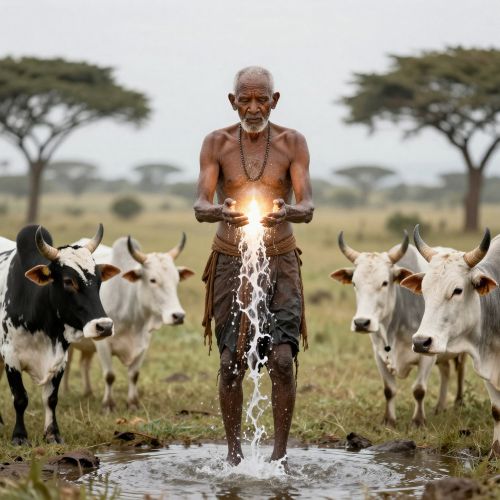Nkole Mythology
Nkole mythology, also known as Ankole mythology, arises from the pastoral heartlands of southwestern Uganda, where rolling hills, long-horned cattle, and the distant shores of Lake Edward define both landscape and legend. The Nkole (Banyankole) people, part of the wider Bantu cultural family, developed a spiritual worldview that weaves together creation, kingship, morality, and the sacred bond between humans, nature, and their divine ancestors. Their myths, passed through generations by griots, elders, and ritual specialists, reveal a world where divine order and pastoral life are one — where the rhythm of cattle bells echoes the heartbeat of creation itself.
At the center of Nkole mythology stands Ruhanga, the supreme creator god who made the earth, the heavens, and all living beings. Ruhanga is the origin of life and the embodiment of truth, order, and justice. He is both distant and omnipresent — not confined to temples or idols but manifest in the cycles of nature and the moral harmony of the community. According to Nkole creation myths, Ruhanga descended to the earth and created the first humans, Kahima, Kairu, and Kakama, testing them to determine their worthiness and destiny. This divine test, often recounted in folklore, became the spiritual foundation of Ankole social identity and moral code.
In the story, Ruhanga provided the three brothers with milk pots and instructed them to watch over them overnight. Kahima’s pot broke, Kairu’s soured, but Kakama’s remained pure. As a result, Ruhanga blessed Kakama to become king, Kahima to herd cattle, and Kairu to till the land. This myth of divine selection established not only the spiritual origin of leadership among the Banyankole but also the sacred hierarchy of life itself — linking kingship, cattle, and agriculture as interconnected expressions of cosmic order. Milk, the essence of sustenance, thus became a holy symbol of purity and life in Nkole cosmology.
Ruhanga’s sons and their descendants are also believed to have shaped the moral and cultural fabric of Ankole society. Ancestors (abazaire) occupy a central place in spiritual life, serving as mediators between humans and Ruhanga. Through ritual, prayer, and offerings, the living seek their blessings for rain, fertility, and protection. The cattle, revered as Ruhanga’s most precious creation, hold sacred value — not merely as economic wealth but as vessels of divine favor. Their horns, milk, and names carry spiritual meaning, reflecting the belief that the wellbeing of cattle and people are inseparable.
The Nkole worldview emphasizes harmony — between heaven and earth, wealth and humility, tradition and renewal. Rituals of thanksgiving, initiation, and rainmaking affirm the people’s covenant with Ruhanga. Priests and elders maintain this balance by invoking divine wisdom through sacred fire, song, and milk libations poured upon the ground as offerings to the ancestors.
Even today, Nkole mythology endures as a living tradition, blending seamlessly with modern identity. Its stories of Ruhanga, Kakama, and the divine milk remind the Banyankole that leadership is sacred service, that prosperity is shared stewardship, and that the divine continues to live within the beauty of the land and the quiet grace of the herd.


